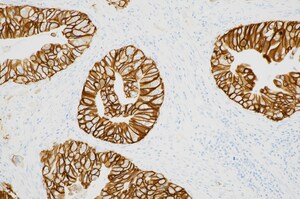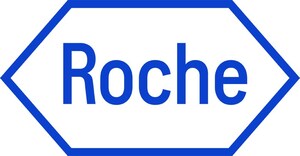Roche expands HIV Global Access Program to include infants in resource limited settings
Program adds early infant testing to further support the 90:90:90 UNAIDS goal
PLEASANTON, Calif., July 19, 2015 /PRNewswire/ -- Roche (SIX: RO, ROG; OTCQX: RHHBY) announced today an expansion to the HIV Global Access Program to include early infant HIV diagnostic testing for low and middle income countries. Roche, in partnership with the Joint United Nations Programme on HIV/AIDS (UNAIDS), the Clinton Health Access Initiative (CHAI), UNITAID, the U.S. President's Emergency Plan For AIDS Relief (PEPFAR) and the Global Fund to fight AIDS, TB and Malaria, is committed to working with the Diagnostics Access Initiative by providing state-of-the-art solutions to achieve the 90-90-90[1] goal set forth by UNAIDS. Announced in 2014, the HIV Global Access Program is Roche's most recent addition to the AmpliCare Initiative, which launched in 2002 in South Africa.
"As the leader in HIV diagnostics, Roche is proud to support the UNAIDS 90-90-90 goal by expanding access to quality HIV testing for early infant diagnosis in resource limited settings," stated Roland Diggelmann, Chief Operating Officer of Roche Diagnostics. "Increased access to early infant diagnosis can provide an impactful contribution for mother and child and contribute to achieving UNAIDS' goals for controlling and eradicating the HIV/AIDS epidemic."
By expanding the Global Access Program for HIV, Roche is providing its dual-target COBAS® AmpliPrep/COBAS® TaqMan® HIV-1 Qualitative Test version 2.0 through an affordable price offering for qualifying organizations in 82 eligible countries with the highest disease burden. The test provides a simple, innovative method for collecting, transporting and storing patient samples in resource-limited settings. The HIV-1 dual-target qualitative test drastically reduces the volume of blood required for testing, while dramatically reducing stress for the mother and the child. Timely HIV infant diagnostics are required for antiretroviral treatment to save the lives of HIV-infected babies across many African countries.
"This agreement with Roche Diagnostics is a powerful step towards ending the unconscionable failure of the world to meet the treatment needs of children living with HIV," said UNAIDS Executive Director Michel Sidibé. "We now need to use this agreement to rapidly scale up diagnostic and treatment services for all children living with HIV, in line with the 90-90-90 target."
"This collaboration illustrates how we are sharing responsibility and working together to end the HIV/AIDS pandemic," said Ambassador Deborah L. Birx, M.D., U.S. Global AIDS Coordinator and U.S. Representative for Global Health Diplomacy. "The U.S. President's Emergency Plan for AIDS Relief (PEPFAR) is scaling up our efforts to identify, test, and treat children living with HIV/AIDS and Roche's decision to include early infant HIV diagnostic testing in the HIV Global Access Program will have a considerable impact—helping PEPFAR expand the reach of our investment."
"This agreement builds on and supports other efforts of a strong partnership to make the market for viral load testing more competitive and transparent, and that better serves children affected by HIV," said Mark Dybul, Executive Director of the Global Fund.
"This agreement will allow more children to be tested and enter treatment sooner saving many lives," said CHAI Chief Executive Officer Ira C. Magaziner. "I congratulate Roche. This represents the latest in a series of agreements where Roche has been a pioneer in bringing state of the art testing to resource poor settings at affordable prices."
About Roche's Tradition of Commitment to HIV Care
Roche announced in 2014, the Global Access Program for increased access to HIV Viral Load as an addition to the AmpliCare Initiative, which launched in 2002 in South Africa. Roche partnered with national governments, local healthcare facilities, communities and international agencies, including CHAI and Centres for Disease Control (CDC), to establish programs that would go beyond providing diagnostic tests. The AmpliCare Initiative was a proactive response to the enormous humanitarian challenge of HIV/AIDS and TB. Since its inception, the program has increased access to HIV viral load tests at substantially reduced prices in sub-Saharan Africa and countries where the disease burden is highest.
Roche also inaugurated the Global Surveillance Program in 1998 at the International AIDS Conference in Geneva. Initially designed to monitor changes in the HIV-1 genomic sequence, the Program and its database have since expanded to include thousands of genomic sequences for multiple viruses, including: HCV, HBV and WNV, in the world's most relevant geographic regions. The Program's efforts have played a monumental role in helping to maintain and improve the reliability of molecular assays.
About Early HIV Infant Diagnosis
Diagnosing HIV in infants and young children is a major challenge. Antibody tests are ineffective in children because the mother's antibodies remain in the child's system following birth. In fact, antibody tests in infants may yield false positive results for up to 15 months. There are a number of alternate methods available for early diagnosis of HIV infected infants. Many approaches use molecular techniques, specifically detecting the viral DNA and/or RNA, which enables HIV diagnosis in less than six weeks.
Early diagnosis is critical for children infected with HIV. If found HIV positive, they can receive appropriate medical care before they develop significant illness, and can remain healthy despite their infection. If found HIV negative, the mother can get appropriate counseling to ensure their child maintains a HIV-free status.
About the Roche dual-target HIV-1 Qualitative Test
The COBAS® AmpliPrep/COBAS® TaqMan® HIV-1 Qualitative Test, version 2.0 is an in vitro diagnostic, total nucleic acid amplification test for the qualitative detection of Human Immunodeficiency Virus Type 1 (HIV-1) DNA and RNA (or total nucleic acid, TNA) in human plasma or dried blood spots using the COBAS® AmpliPrep Instrument for automated specimen processing and the COBAS® TaqMan® Analyzer or COBAS® TaqMan® 48 Analyzer for automated amplification and detection. The dual-target test is designed for broad HIV-1 detection in the presence of naturally-occurring and drug-induced mutations.
The test is a diagnostic test, indicated for individuals who are suspected to be actively infected with HIV-1. Detection of HIV-1 TNA is indicative of active HIV infection. Infants born to mothers infected with HIV-1 may have maternal antibodies to HIV-1, and the presence of HIV-1 nucleic acid in the infant indicates active HIV-1 infection. In adults, the test may be used as an aid in the diagnosis of HIV-1 infection.
About HIV-1
Accordingly to the World Health Organization (WHO), there were 35 million people including 3.2 million children under 15 living with HIV around the world in 2013. That same year 2.1 million people, including 240,000 children under 15 years, became newly infected with HIV worldwide.[2] For the most impacted region of Sub-Saharan Africa nearly 1 in every 20 adults of all people living in this region are HIV positive.
The transmission of HIV from an HIV-positive mother to her child during pregnancy, labor, delivery or breastfeeding is called vertical or mother-to-child transmission (MTCT). In the absence of any interventions HIV transmission rates are between 15-45%.
Accurate diagnosis, highly active antiretroviral treatment (HAART) and viral load testing, a test to determine the amount of circulating HIV, have contributed to a steady increase in life expectancy for HIV infected people of 13 years.[3]
About Roche
Headquartered in Basel, Switzerland, Roche is a leader in research-focused healthcare with combined strengths in pharmaceuticals and diagnostics. Roche is the world's largest biotech company, with truly differentiated medicines in oncology, immunology, infectious diseases, ophthalmology and neuroscience. Roche is also the world leader in in vitro diagnostics and tissue-based cancer diagnostics, and a frontrunner in diabetes management. Roche's personalised healthcare strategy aims at providing medicines and diagnostics that enable tangible improvements in the health, quality of life and survival of patients. Founded in 1896, Roche has been making important contributions to global health for more than a century. Twenty-eight medicines developed by Roche are included in the World Health Organization Model Lists of Essential Medicines, among them life-saving antibiotics, antimalarials and chemotherapy.
In 2014, the Roche Group employed 88,500 people worldwide, invested 8.9 billion Swiss francs in R&D and posted sales of 47.5 billion Swiss francs. Genentech, in the United States, is a wholly owned member of the Roche Group. Roche is the majority shareholder in Chugai Pharmaceutical, Japan. For more information, please visit www.roche.com.
COBAS, AMPLIPREP, and TAQMAN are trademarks of Roche.
All trademarks used or mentioned in this release are protected by law.
For media inquiries please contact:
Bob Purcell, Roche Molecular Diagnostics, 888-545-2443
[1] This goal means that 90% of people living with HIV will know their HIV status, 90% of all people with diagnosed HIV infection will receive sustained antiretroviral therapy, and 90% of all people receiving antiretroviral therapy will have durable viral suppression by the year 2020. Optimizing the use of diagnostics will be critical to achieving the first 90 target, thereby enabling the achievement of the remaining targets.
[2] The UNAIDS Report on the Global AIDS Epidemic 2014.
[3] Lancet. Volume 372, Issue 9635, 26 July 2008-1 August 2008, Pages 293-299.
SOURCE Roche
Related Links
WANT YOUR COMPANY'S NEWS FEATURED ON PRNEWSWIRE.COM?
Newsrooms &
Influencers
Digital Media
Outlets
Journalists
Opted In






Share this article